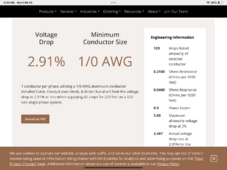Bluedog225
Texas
- Joined
- Nov 18, 2019
- Messages
- 2,921
Good evening everyone,
I really need to get this right. Any help appreciated.
I’ve got a conex with the inverter and batteries 200 feet from the cabin. Between the two, I have 2” schedule 80 pvc conduit buried at 30 inches. A gentle curve with two 90 degree turns-one at the conex and one at the cabin.
My ultimate plan is two Victron Quattro 48/5000 inverters for split phase to the cabin.
1. Is it 5000 watts divided by 120 volts? Therefore 41.67 amps per line? The spec sheet for the Quattro says “5000 VA.” Then it de-rates to watts. I’m not sure how to translate VA into real world wire size needed.
2. Should I calculate a 3% voltage drop? Or would more conservative be better? 2% or 1%? And do I increase the line length to account for the farthest run in the actual cabin? About 225’. I’m ok planning a lower voltage drop, and spending the extra cash, if it’s going to make a difference.
3. I’m guessing aluminum is fine, ok, good enough? Or is copper going to give me a longer service life? Any other considerations on aluminum versus copper?
4. Line one, line two, neutral, and ground. So 4 wires, right? And I’m reading that THWN separate strands is preferable for ease of pulling. Is this the right call? Or is there an advantage to going with 4 conductor direct burial underground feeder even though it will be inside the conduit?
5. What temperature rating should I look for on the wire?
6. The wire size calculator is asking me “raceway, cable, buried in earth, or open air.” I’m not sure which one to pick as I’m using conduit.
If I can get these pinned down, I can make a decision on the actual wire.
Happy to provide any other information that may be helpful.
Many thanks
I really need to get this right. Any help appreciated.
I’ve got a conex with the inverter and batteries 200 feet from the cabin. Between the two, I have 2” schedule 80 pvc conduit buried at 30 inches. A gentle curve with two 90 degree turns-one at the conex and one at the cabin.
My ultimate plan is two Victron Quattro 48/5000 inverters for split phase to the cabin.
1. Is it 5000 watts divided by 120 volts? Therefore 41.67 amps per line? The spec sheet for the Quattro says “5000 VA.” Then it de-rates to watts. I’m not sure how to translate VA into real world wire size needed.
2. Should I calculate a 3% voltage drop? Or would more conservative be better? 2% or 1%? And do I increase the line length to account for the farthest run in the actual cabin? About 225’. I’m ok planning a lower voltage drop, and spending the extra cash, if it’s going to make a difference.
3. I’m guessing aluminum is fine, ok, good enough? Or is copper going to give me a longer service life? Any other considerations on aluminum versus copper?
4. Line one, line two, neutral, and ground. So 4 wires, right? And I’m reading that THWN separate strands is preferable for ease of pulling. Is this the right call? Or is there an advantage to going with 4 conductor direct burial underground feeder even though it will be inside the conduit?
5. What temperature rating should I look for on the wire?
6. The wire size calculator is asking me “raceway, cable, buried in earth, or open air.” I’m not sure which one to pick as I’m using conduit.
If I can get these pinned down, I can make a decision on the actual wire.
Happy to provide any other information that may be helpful.
Many thanks




